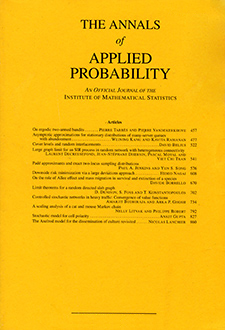Abstract
The antique Mills Futurity slot machine has two unusual features. First, if a player loses 10 times in a row, the 10 lost coins are returned. Second, the payout distribution varies from coup to coup in a manner that is nonrandom and periodic with period 10. It follows that the machine is driven by a 100-state irreducible period-10 Markov chain. Here, we evaluate the stationary distribution of the Markov chain, and this leads to a strong law of large numbers and a central limit theorem for the sequence of payouts. Following a suggestion of Pyke [In Mathematical Statistics and Applications: Festschrift for Constance van Eeden (2003) 185–216 Institute of Mathematical Statistics], we address the question of whether there exists a two-armed version of this “one-armed bandit” that obeys Parrondo’s paradox. More precisely, is there such a machine with the property that the casino can honestly advertise that both arms are fair, yet when players alternate arms in certain random or nonrandom ways, the casino makes money in the long run? The answer is a qualified yes. Although this “history-dependent” game is conceptually simpler than the original such games of Parrondo, Harmer and Abbott [Phys. Rev. Lett. (2000) 85 5226–5229], it is nearly as complicated analytically, and open problems remain.
Citation
S. N. Ethier. Jiyeon Lee. "A Markovian slot machine and Parrondo’s paradox." Ann. Appl. Probab. 20 (3) 1098 - 1125, June 2010. https://doi.org/10.1214/09-AAP653
Information





